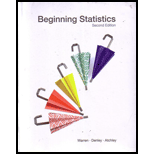
To find:
To perfom the test statistic for the following scenerio,
“A manufacturer of children’s vitamins claims that its vitamins are mixed so the each batch has exactly the following percentage of each color: 20% green, 40% yellow, 10% red, and 30% orange. To test the claim that these percentage are incorrect, 100 bottles of vitamins were pulled and the clors of the vitamins were tailled”.
Answer to Problem 26E
Solution:
(a)
(b) Use the chi-square test for this goodness of fit and the level of siginificance is
(c) The test statistic value is
(d) There is sufficient evidence to support that percentages stated by the vitamin manufacturer are incorrect.
Explanation of Solution
The following table represents the random sample of number of vitamins and the color
of vitamins is,
| Children's Vitamins | ||||
| Green | Yellow | Red | orange | |
| Number | 1149 | 1948 | 552 | 1401 |
Step 1: To state the null and alternative hypotheses.
When starting the hypotheses to be used we take the null hypothesis to be that the proportion percentages stated by the vitamin manufacturer are not incorrect.
Null hypothesis:
Alternative hypothesis:
Let
Mathematically, we can write the null and alternative hypothesis for four different vitamins as follows,
Step 2: To determine whether the observed values proportion of color of vitamins is match with the expected values of proportion of color of vitamins. Since we assume that the necessary condition that have been met. So, use the chi-square test for this goodness of fit and the level of siginificance is
Step 3: To calculate the test statistic.
Let‘s calculate the expected value of color of vitamins. Since we are assuming that the proportion percentages stated by the vitamin manufacturer are not incorrect is calculated as follows,
And,
Formula for calculating test statistic for a Chi-Square test for goodness of fit:
The test statistic for a chi-square test for goodness of fit is given below,
Where Oi, is the observed frequency for the ith possible outcome and Ei is the expected frequency for the ith possible outcome and n is the sample size.
From the above table represent the value of n is 5050.
The following table represents the test statistic,
| Children's Vitamins | Observed Values | Expected Values | |||
| Green | 1149 | 1010 | 139 | 19321 | 19.1297 |
| Yellow | 1948 | 2020 | -72 | 5184 | 2.56634 |
| Red | 552 | 505 | 47 | 2209 | 4.37426 |
| Orange | 1401 | 1515 | -114 | 12996 | 8.57822 |
Step 4: Degrees of freedom in a Chi-square test for goodness of fit:
In a chi-square test for goodness of fit the number of degrees of freedom for the chi-square distribution of the test statistic is given by,
Where k is the number of possible outcomes for each trial.
Rejection Region for Chi-Square Test for Association:
Reject the null hypothesis,
From the given information k = 4.
Substitute the above values in the formula of degrees of freedom to get the following,
Conclusion:
Use the level of significance of
Use the “Area to the right of the critical value
The test statistic value is
By using the above condition we reject the null hypothesis.
Since,
So, there is sufficient evidence to support that percentages stated by the vitamin manufacturer are incorrect.
Final statement:
(a)
(b) Use the chi-square test for this goodness of fit and the level of siginificance is
(c) The test statistic value is
(d) There is sufficient evidence to support that percentages stated by the vitamin manufacturer are incorrect.
Want to see more full solutions like this?
Chapter 10 Solutions
Beginning Statistics, 2nd Edition
 MATLAB: An Introduction with ApplicationsStatisticsISBN:9781119256830Author:Amos GilatPublisher:John Wiley & Sons Inc
MATLAB: An Introduction with ApplicationsStatisticsISBN:9781119256830Author:Amos GilatPublisher:John Wiley & Sons Inc Probability and Statistics for Engineering and th...StatisticsISBN:9781305251809Author:Jay L. DevorePublisher:Cengage Learning
Probability and Statistics for Engineering and th...StatisticsISBN:9781305251809Author:Jay L. DevorePublisher:Cengage Learning Statistics for The Behavioral Sciences (MindTap C...StatisticsISBN:9781305504912Author:Frederick J Gravetter, Larry B. WallnauPublisher:Cengage Learning
Statistics for The Behavioral Sciences (MindTap C...StatisticsISBN:9781305504912Author:Frederick J Gravetter, Larry B. WallnauPublisher:Cengage Learning Elementary Statistics: Picturing the World (7th E...StatisticsISBN:9780134683416Author:Ron Larson, Betsy FarberPublisher:PEARSON
Elementary Statistics: Picturing the World (7th E...StatisticsISBN:9780134683416Author:Ron Larson, Betsy FarberPublisher:PEARSON The Basic Practice of StatisticsStatisticsISBN:9781319042578Author:David S. Moore, William I. Notz, Michael A. FlignerPublisher:W. H. Freeman
The Basic Practice of StatisticsStatisticsISBN:9781319042578Author:David S. Moore, William I. Notz, Michael A. FlignerPublisher:W. H. Freeman Introduction to the Practice of StatisticsStatisticsISBN:9781319013387Author:David S. Moore, George P. McCabe, Bruce A. CraigPublisher:W. H. Freeman
Introduction to the Practice of StatisticsStatisticsISBN:9781319013387Author:David S. Moore, George P. McCabe, Bruce A. CraigPublisher:W. H. Freeman





